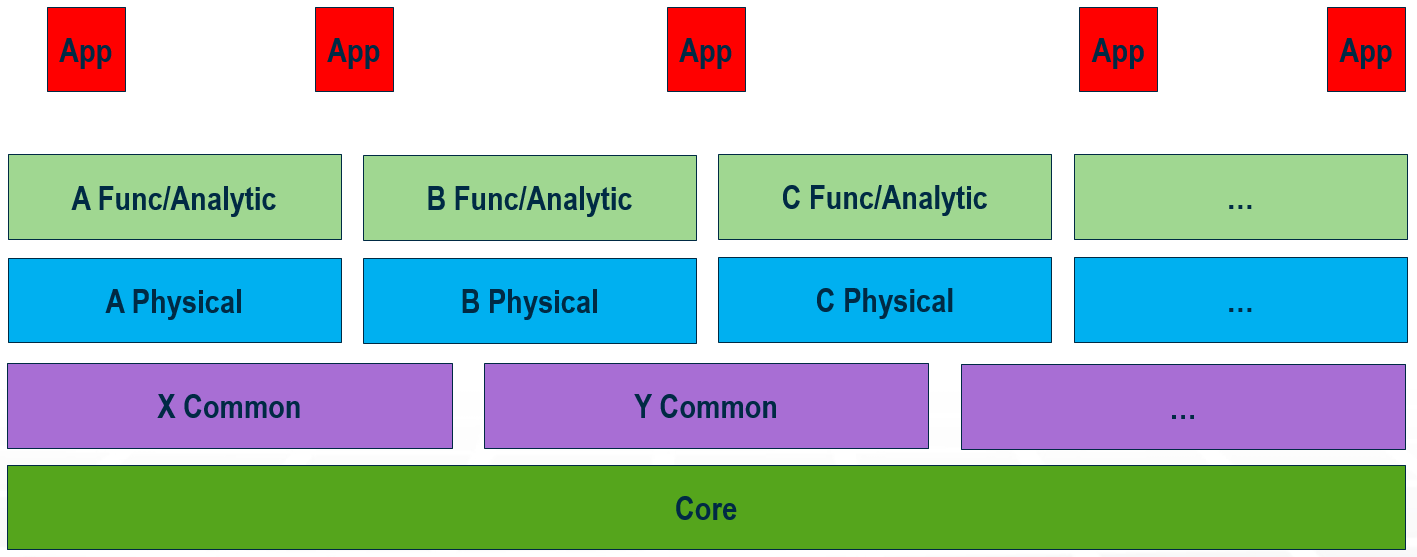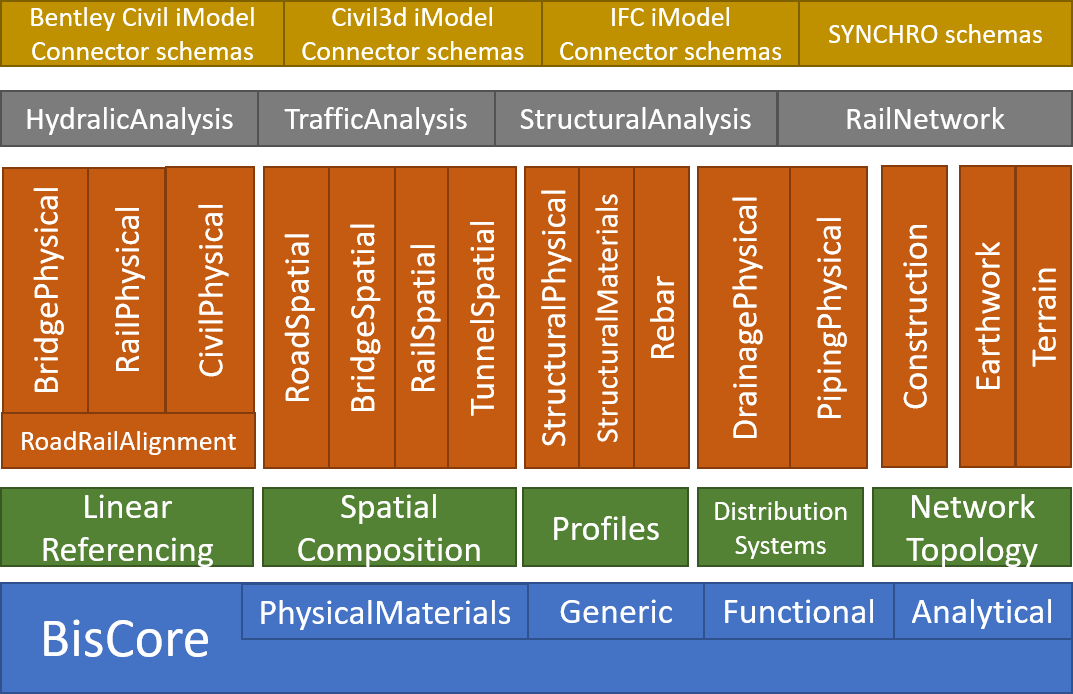Schemas (“Domains”)
Introduction
Domain is a synonym for BIS ECSchema. Domains define the data types for a naturally coherent and limited subject matter. This approach aims to avoid problems and complexities associated with understanding and managing monolithic or very large schemas. It highly depends on coordination and cooperation among multiple BIS domain designers so each sharable concept needed by BIS applications find its appropriate home (i.e. domain) where it will be managed and maintained.
With Domains being the main concept in BIS behind how the world is divided in, and each domain being small enough to have a clear scope and owner, BIS can also be thought as a modular family of “domain” schemas.
A Layered Approach
Domains are organized into layers based on how generic or specialized the subject matter of the ECSchema in a domain is. The most generic ECSchema in BIS, which lies at the base of this hierarchy – depicted in the figure below – is BisCore.
Schemas in any layer may be dependent upon schemas at the same or any lower layer. The layers of the schema hierarchy are intended to avoid circular dependencies while still allowing different domains to interoperate.

The BisCore layer
BisCore defines the core ECClasses and organizational strategies that all other data types in other domains must follow. Classes such as Model, Element and UniqueAspect are in the BisCore schema.
The Common layer
The next layer in the BIS family of ECSchemas above “Core” is "Common". That is where broad concepts applicable to multiple disciplines are defined. As an example, a Building “Common” schema may include concepts like grids, but not details of architecture (such as Windows), or structure (such as beams).
The layers above "Common" specialize on a single discipline (in the figure above, sharing the same initial letter), while differentiating in their purpose: "Physical" and "Other" (e.g. Functional/Analytical).
The Discipline-Physical layer
“Physical” and “Functional/Analytical” domains model a particular discipline from different perspectives.
The Discipline-Physical layer defines real-world physical entities and closely associated information, in light of a specific discipline. Classes such as Pump, Pipe or Column are in the Discipline-Physical layer. This layer also comprises discipline-specific concepts introduced in terms of the concepts and patterns established by the Spatial Composition schema, such as Building, Road or Bridge.
The Discipline-Other layer
This layer defines data types for modeling perspectives other than Physical. Functional or analytical schemas enabling various schematics and simulations are examples of this layer.
The Application Layer
The top layer is for any needed application schema. These schemas contain no data that any other application would need to access. Product and iModel Connector schemas are examples of this layer.
Physical Backbone
A key organizational strategy for both the BIS schemas and the organization of data within BIS repositories is the “physical backbone”. For schema design the physical world is a unifying reality upon which all disciplines can agree when coming to a consensus on how to represent something in BIS.
Within a BIS repository, the representation of the physical world becomes the framework upon which we can organize other data. All data in BIS repositories is expected to be about or related to physical infrastructure. The physical infrastructure is modeled as a hierarchy and other non-physical information (e.g. Functional or Analytical perspectives) is typically stored relative to that hierarchy. However, it is expected that in some workflows the physical infrastructure appears after other non-physical data is modeled. Thus, the concept of a “physical backbone”, albeit not being mandatory from the start of a BIS repository, should drive the design of the various domains in a discipline.
Domain Handlers
The BIS schema for a Domain is expected to be useful to a wide variety of clients, designed with the mindset that multiple products, or other domains if needed, will make use of them. Furthermore, as part of the implementation of a BIS Domain, a cross-platform Typescript component – usually referred to as a “Domain Handler” – can optionally be implemented, representing code that understands the BIS ECSchema the Domain is about, is able to read and modify its data in a coherent manner, as well as exposing public APIs providing special functionality to make working with its ECSchema easier and less error-prone.
Lifecycle Considerations
Disciplines that will be using BIS usually focus on the entire lifecycle of infrastructure assets. That is, conceptual/detailed design, construction, operations and maintenance lifecycle phases. BIS, at its core, does not intend to break up schemas further into lifecycle phases, but rather be agnostic of them. Thus, a domain BIS ECSchema should be designed so that it can accommodate data at various phases. The quality and/or detail of data for any BIS concept modeled by an ECSchema should evolve as it “flows” through lifecycle phases. No import/export workflows shall be needed.
Designing BIS schemas backwards (i.e. understanding concepts needed for Operations and Maintenance first, while leaving Conceptual Design last) may help to identify all needed pieces towards achieving a schema that works for the entire lifecycle of the infrastructure of interest.
Example
Taking Road & Rail disciplines as a example, the following figure depicts how they can be divided into various BIS domains.

At the lowest layer - Core - the BisCore schema is the most generic domain which lays out the framework and foundation for all other BIS domains. Other Core layer schemas depicted in the figure above include PhysicalMaterials, Functional, Analytical and Generic.
Next layer up – Common – domains targeting abstract concepts can be found. Those include domains such as Linear-Referencing, Network-Topology, Profiles and Distribution Systems.
Above Common, discipline-specific layers are introduced. In the case of Road & Rail, the Discipline-Physical layer depicts domains that introduce fundamental pieces such as Alignments – based on Linear-Referencing – Earthwork and Terrain. Other related domains are shown, which focused on Physical-modeling and Spatial-Composition of Road and Railway infrastructure, such as Bridges, Tunnels and Drainage.
Other domains in Road & Rail disciplines that focus on other modeling perspectives included in the figure above are: Structural Analysis (applicable to bridges and tunnels), Traffic Analysis and Hydraulic Analysis.
Lastly, several application schemas, including iModel Connector schemas, can be built on top of all these Road & Rail domains. These Civil applications may focus on specific assets and lifecycle phases in the Road & Rail disciplines. However, BIS ECSchemas referenced by them are expected to be useful across the entire lifecycle of assets in the Road & Rail disciplines.
| Next: Information Hierarchy |:---
Last Updated: 11 June, 2025